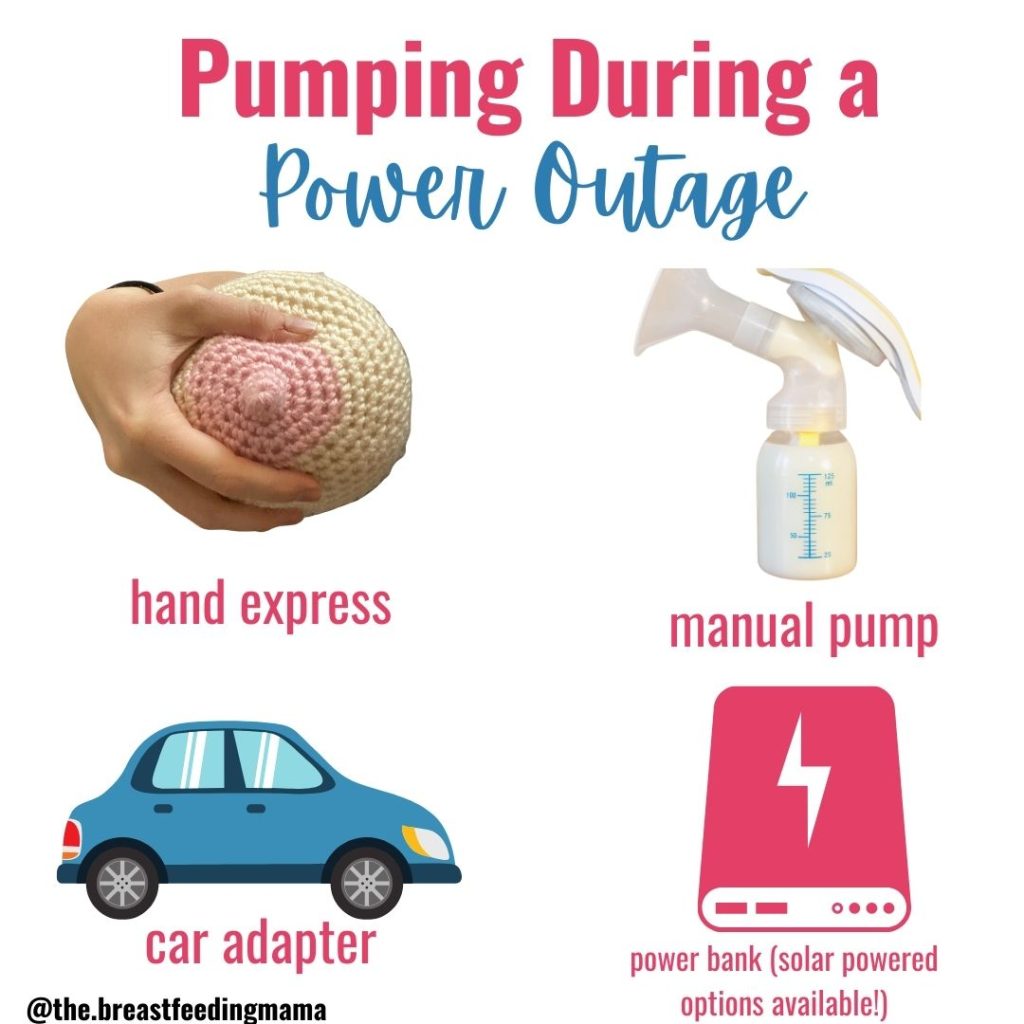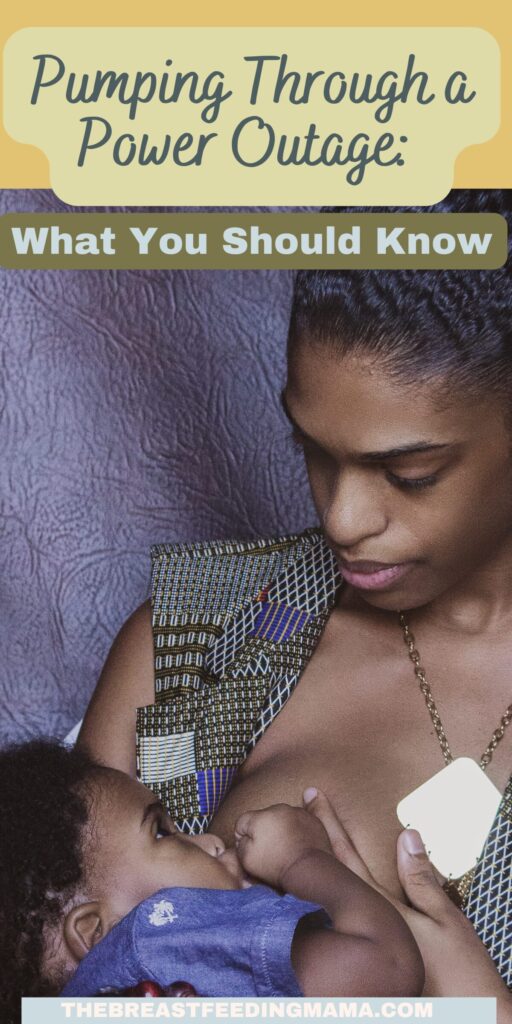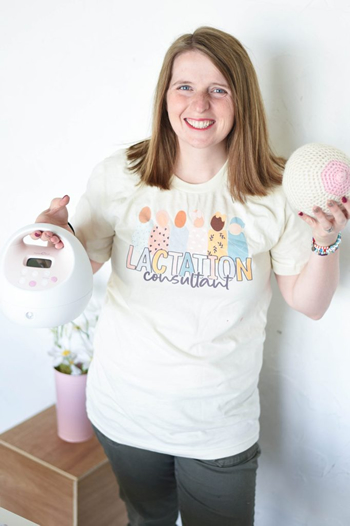If the power has gone out – or a power outage is imminent – it can be a scary time for new parents. If you are breastfeeding/pumping through a power outage, here are a few tips for making it a little less difficult.
Parenting through any kind of disaster can be frustrating and scary.
A power outage brings its own set of problems. With the massive power outages going in in Texas right now, I know a lot of people are feeling the effects of that, especially when it comes to breastfeeding and pumping.
I’m a big believer in personal preparedness, but the reality is, there are just some things you don’t think about until you are faced with them.
In this post, I wanted to share a few tips for surviving a power outage as a breastfeeding/pumping parent – whether you are in the midst of one or you just want to prepare for the worst, I hope that this will be a helpful post.

Tips for Expressing Milk During a Power Outage

If you rely on pumping, realizing that you can’t plug your pump in to use can be very scary. Here are a few tips on what to do.
Hand Express
One of the greatest resources you’ve been equipped with is your hands. Hand expression can absolutely replicate pumping and might be your saving grace during a disaster.
It’s helpful to learn how to hand express from the start, as it can be a learned skill – but if worse comes to worse and you’ve never hand expressed before, you should be able to do it still.
Here is an article I wrote on hand expression that has some advice. You do need to make sure you are hand expressing into a clean container. You can also grab my free hand expression printable below.
Manual Pump
This is an item that I think everyone should invest in, especially for emergency prep. They are generally less than 30 dollars, and they require no electricity. They are widely available at stores like Walmart, Target, and Amazon. Even if you think you won’t need one, you definitely want to store this in your emergency prep kit – who knows, another parent you know might need it and you could help them out.
Car Adapter
Most pumps should have a car adapter that either comes with it or that you can purchase separately. If you have a car and an adapter, you can pump in the car.
Just make sure to follow car safety to ensure you don’t harm yourself from sitting in a car that is turned on.
Batteries
If your pump is powered by a battery, make sure you have a couple of extras on hand for emergencies – whether it be an extra rechargeable batteries or some AA or AAA batteries.
Portable Power Bank
A power bank can be a really useful tool to have – if you have a pump that is charged by USB, I would definitely invest in one of these. Obviously, they will only work if charged, so consider buying one that you just keep completely charged so you can use it to charge your pump.
There are some power banks that are solar powered, so that might be a good option as well.
There are also portable power stations that will have a place you can plugin in a wall plug. These are typically more expensive but might be something you consider getting.
Here are some pumps that have USB chargers
- Willow Breast Pump
- Elvie
- Baby Buddha
- Medela Freestyle Flex
- Spectra
Keep your Pump Charged
If the power is already out and your pump isn’t charged, this obviously won’t apply to you. But I recommend ALWAYS keeping your pump fully charged in case of something suddenly happening. It should give you a few hours or days worth of pumping (depending on your pump).
Sanitizing Pump and Bottle Parts During a Disaster
Not being able to clean your bottles and pump parts can pose a problem if you are without power and water.
If you run into this, I recommend, at the minimum, having some pump wipes to thoroughly wipe down the parts. You can use the “fridge hack” if it’s cold enough outside by putting the parts in a Ziploc bag and putting it outside. If you have a cooler with ice in it, you could put them in there.
If you have clean and running water, obviously clean them as you normally would. If the water is not warm and you have access to a camp stove or other heating receptacle that doesn’t require electricity, you can boil the water there.
Finally, if it’s snowing outside and you have an electric-free camping stove of some type, you can fill a big pot with CLEAN snow, boil it, and then wash and sanitize the parts in there.
Milk Storage
In this post, I talk about what to do with your frozen breast milk in the freezer during a power outage, so be sure to check that one out.
Otherwise, make sure you are following proper milk storage guidelines as best you can. If you know a power outage is imminent and you have a Yeti cooler (or something like that) you could consider filling that with ice – dry ice might be even better – which could help with storing milk that you’ve expressed.
What if you run out of milk?
For someone who relies on expressed breast milk, this can be a disaster. I would get in contact with the local milk banks in your area or your local chapter of Human Milk 4 Human Babies to see if there are any donors in your area.
You can obviously use formula as well if you have access to it, but if there isn’t water available, this isn’t a viable option.
More Posts You May Enjoy:
- Two Simple Ways to Scald Breast Milk to Fix High Lipase
- Top Signs of Low Milk Supply to Worry About
- How to Hand Express Breast Milk – and the Amazing Reasons Why All Moms Should Know How to!
- How Much Breast Milk in a Bottle – Baby Milk Intake Calculator







